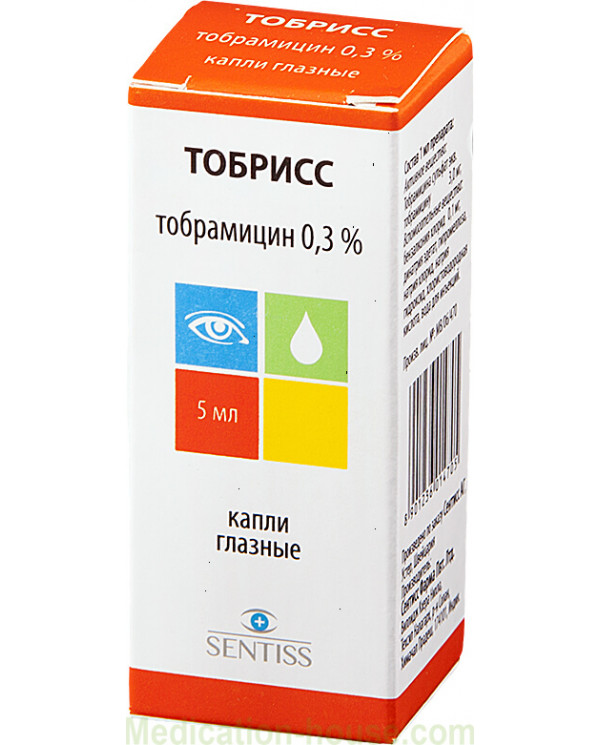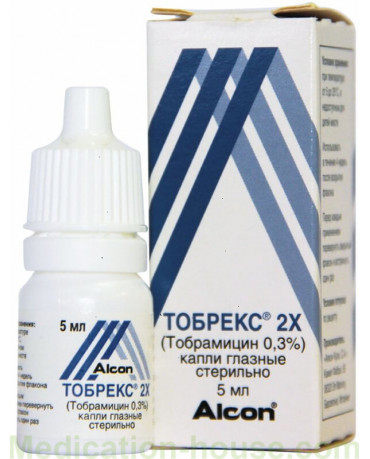Instruction for Tobriss
You can buy Tobriss on this page
Release form and composition
Dosage form - eye drops: colorless or pale yellow transparent solution (5 ml each in a plastic dropper bottle with a screw cap; in a cardboard box 1 dropper bottle and instructions for use of Tobriss).
1 ml drops contain:
active substance: tobramycin - 3 mg;
additional components: disodium edetate, hypromellose, sodium hydroxide or hydrochloric acid, benzalkonium chloride, sodium chloride, water for injection.
Pharmacodynamics
Tobramycin is an antibacterial drug from the group of III generation aminoglycosides, with a wide spectrum of action. At low concentrations, it exhibits a bacteriostatic effect, blocking the 30S ribosome subunit and inhibiting protein production. At high concentrations, tobramycin has a bactericidal effect, by disrupting protein synthesis and permeability of the cytoplasmic membrane of the microorganism cell, which leads to its death.
Microorganisms sensitive to tobramycin: gram-positive aerobes - Corynebacterium, Staphylococcus aureus (methicillin-sensitive); coagulase-negative types of staphylococci (methicillin-sensitive, including strains resistant to penicillin); gram-negative bacteria - Haemophilus influenzae, Escherichia coli, Acinetobacter spp., Klebsiella spp., Morganella morganii, Moraxella spp., Pseudomonas aeruginosa.
Microorganisms resistant to tobramycin: gram-positive aerobes - some species of Staphylococcus, methicillin-resistant with an incidence of resistance up to 50% of all types of staphylococci in certain European countries; most of the strains of group D streptococci, Streptococcus pneumoniae.
Some gentamicin-resistant strains are highly susceptible to tobramycin. The development of resistance to the latter occurs as a result of the modification and inactivation of antibiotics by enzymes located in the periplasmic space of bacteria. Aminoglycosides can be inactivated by three different mechanisms: acetylation of amino groups, adenylation of hydroxyl groups, and phosphorylation of hydroxyl groups.
Variable sensitivity to other classes of modified enzymes is also possible between antibiotics from the aminoglycoside group. The most common mechanism of acquired aminoglycoside resistance is antibiotic inactivation through transformation of transposon-encoded enzymes and plasmids. The change in resistance may be due to the geographic location for the respective bacterial species; therefore, it is advisable (especially in the treatment of severe infections) to have local information regarding resistant microorganisms.
Below are the critical values of the minimum inhibitory concentration (MIC) of the drug (in mg / ml), separating sensitive microorganisms (S) - MIC ≤ 4 mg / ml from conditionally sensitive and the latter from resistant (R) - MIC ≥ 8 mg / ml:
Staphylococcus aureus - 0.2;
Streptococcus pyogenes 12.5;
Streptococcus pneumoniae - 25;
Proteus mirabilis - 1.2;
Proteus morganii - 1.2;
Proteus vulgaris - 1.2;
Proteus rettgeri - 2.5;
Haemophilus - 0.5;
Pseudomonas aeruginosa - 0.6;
Klebsiella pneumoniae - 0.8;
Escherichia coli - 1.2;
Neisseria - 5.
Pharmacokinetics
With local use of Tobriss, systemic absorption of tobramycin is negligible. It does not pass well through the cornea of the eye.
After instillation of the solution, the content of tobramycin in the aqueous humor of the eye is not determined. Increasing the frequency of administration can help increase the concentration of the agent in the aqueous humor.
Indications for use
The drug is recommended for use in children older than 2 months and adults for the treatment of infectious lesions of the anterior segment of the eyeball, excited by microorganisms sensitive to tobramycin.
Contraindications
infancy up to 2 months;
lactation period;
hypersensitivity to the active and auxiliary components that make up Tobriss eye drops.
Instructions for use: method and dosage
Tobriss eye drops are used topically by instillation into the conjunctival sac.
With a mild course of the infectious process, it is recommended to inject the drug 1 drop 2 times / day, morning and evening.
In severe cases of infection, 1 drop should be administered during the waking period with the frequency of injections on the first day of treatment - 4 times, on the following days - 2 times daily.
The general course of therapy is on average 7 days (6–8 days).
In order to prevent contamination of the solution and the tip of the dropper bottle, it is required to avoid contact of the latter with the periorbital region, eyelids or other surfaces. After the procedure, the bottle must be tightly closed.
In the case of joint use of Tobriss with other medicinal products for local use in ophthalmology, the interval between instillations should be at least 5-10 minutes.
When used topically, tobramycin is characterized by low systemic exposure. In patients with impaired hepatic and renal function in the case of the combined use of Tobriss with aminoglycoside antibiotics of systemic action, the plasma level of these agents should be monitored to maintain adequate systemic concentrations.
Side effects
During treatment with the drug, the most frequently recorded adverse effects were toxicity and local hypersensitivity, including lacrimation, itching and swelling of the eyelids, conjunctival injection.
Adverse reactions, information about which was obtained in the course of clinical trials and post-registration experience of using Tobriss:
organ of vision: often - itching of the eyelids, discomfort in the eye, allergic phenomena from the eyes, conjunctival infection; infrequently - lacrimation, dry eye syndrome, itching / pain in the eye, discharge from the eyes, edema of the eyelids, erythema of the eyelids, edema of the conjunctiva, blurred vision, corneal erosion, blurred vision, keratitis; frequency unknown - eye irritation;
nervous system: infrequently - headache;
skin and subcutaneous fat: infrequently - dry skin, itching, leukoderma, dermatitis, madarosis, urticaria; frequency unknown - rash, erythema;
immune system: infrequently - hypersensitivity (if symptoms of hypersensitivity occur, Tobriss must be canceled).
Overdose
The occurrence of toxic effects with topical application of Tobriss in ophthalmology or its accidental oral administration is not expected.
Symptoms of an overdose of tobramycin when used in the form of eye drops can be disorders similar to the side effects observed during therapy, including itching of the eyelids, lacrimation, erythema of the eyelids, conjunctival edema, and punctate keratitis.
Special instructions
Tobriss solution is not intended for oral and parenteral administration, it should be used only topically in ophthalmology.
Some patients have hypersensitivity to topical ophthalmic agents from the aminoglycoside group. It is required to take into account that with the development of hypersensitivity to tobramycin, hypersensitivity to other aminoglycosides for local / systemic use is also possible.
With oral administration of tobramycin, serious side effects have been noted, including ototoxic, nephrotoxic and neurotoxic reactions. In the case of the combined use of Tobriss with systemic aminoglycosides, care must be taken, due to the aggravation of the severity of systemic undesirable effects.
During the period of prolonged treatment with the drug, an increased growth of microorganisms that are immune to its action (including fungi) is possible. If the development of superinfection is observed, it is necessary to stop the instillation of Tobriss.
During the treatment of infectious eye lesions, the use of contact lenses is not recommended. Benzalkonium chloride, which is part of the drops, can cause eye irritation and discoloration of soft contact lenses, so avoid contact with the surface of the latter. Contact lenses must be removed before the introduction of Tobriss and reinstalled no earlier than 15 minutes after the end of instillation.
Influence on the ability to drive vehicles and complex mechanisms
After instillation of Tobriss eye drops, a temporary decrease in the clarity of visual perception is possible, until it is fully restored, it is not recommended to drive vehicles and perform types of work that require increased attention and accelerated response.
Application during pregnancy and lactation
In the case of oral administration of tobramycin in doses significantly higher than those recommended for instillations, nephro- and ototoxicity was observed. When ingested, the substance enters the amniotic fluid and fetal blood through the placenta. In the case of parenteral administration of tobramycin, like other aminoglycosides, risks to the fetus have not been established. After instillation of the substance in the form of eye drops, its high plasma level is not expected.
Reproductive toxicity has been determined in animal studies of the antibacterial agent. Data on the use of Tobriss in pregnant women are limited or absent, therefore its use during pregnancy is not recommended.
After parenteral and oral administration, tobramycin is excreted in significant quantities in breast milk, after its topical use in the form of instillations, such excretion is unlikely. Despite this, if it is necessary to treat the drug during lactation, it is necessary to stop breastfeeding.
The effect of tobramycin in this dosage form on human fertility has not been studied.
Pediatric use
In children older than 2 months, drug therapy can be carried out in the same doses as in adults.
For infants under 2 months of age, instillation of Tobriss is contraindicated due to the lack of reports confirming its safety and efficacy in patients of this age group.
Use in the elderly
Elderly people do not need to adjust the dosage regimen.
Drug interactions
Studies of the interaction of Tobriss with other drugs / drugs have not been conducted.
Against the background of the combined use of the drug and local ophthalmic corticosteroids, clinical manifestations of viral, fungal and bacterial eye diseases can be masked, and hypersensitivity reactions can be inhibited.
Terms and conditions of storage
Store in a place protected from light, out of the reach of children, at a temperature not exceeding 30 ° C, without freezing.
Shelf life is 2 years.
After opening the bottle, you can store and use the drug for no more than 30 days.
Reviews
In most cases, patients leave positive reviews about Tobriss, in which they note the effectiveness and rapid action of the drug in the treatment of infectious eye diseases, including bacterial conjunctivitis. The advantages of eye drops include the possibility of their use in infants over the age of 2 months. The solution does not cause discomfort after instillation, and has a relatively low cost.
To the disadvantages of Tobriss, many patients attribute a short shelf life after opening the bottle, as well as the fact that drops are not recommended for use during pregnancy and lactation. Sometimes they indicate a lack of funds in pharmacies. There are practically no complaints about the development of adverse events. In rare cases, there are reports of insufficient therapy effect.
Terms of sell
You don't need a prescription from a doctor to buy Tobriss.


